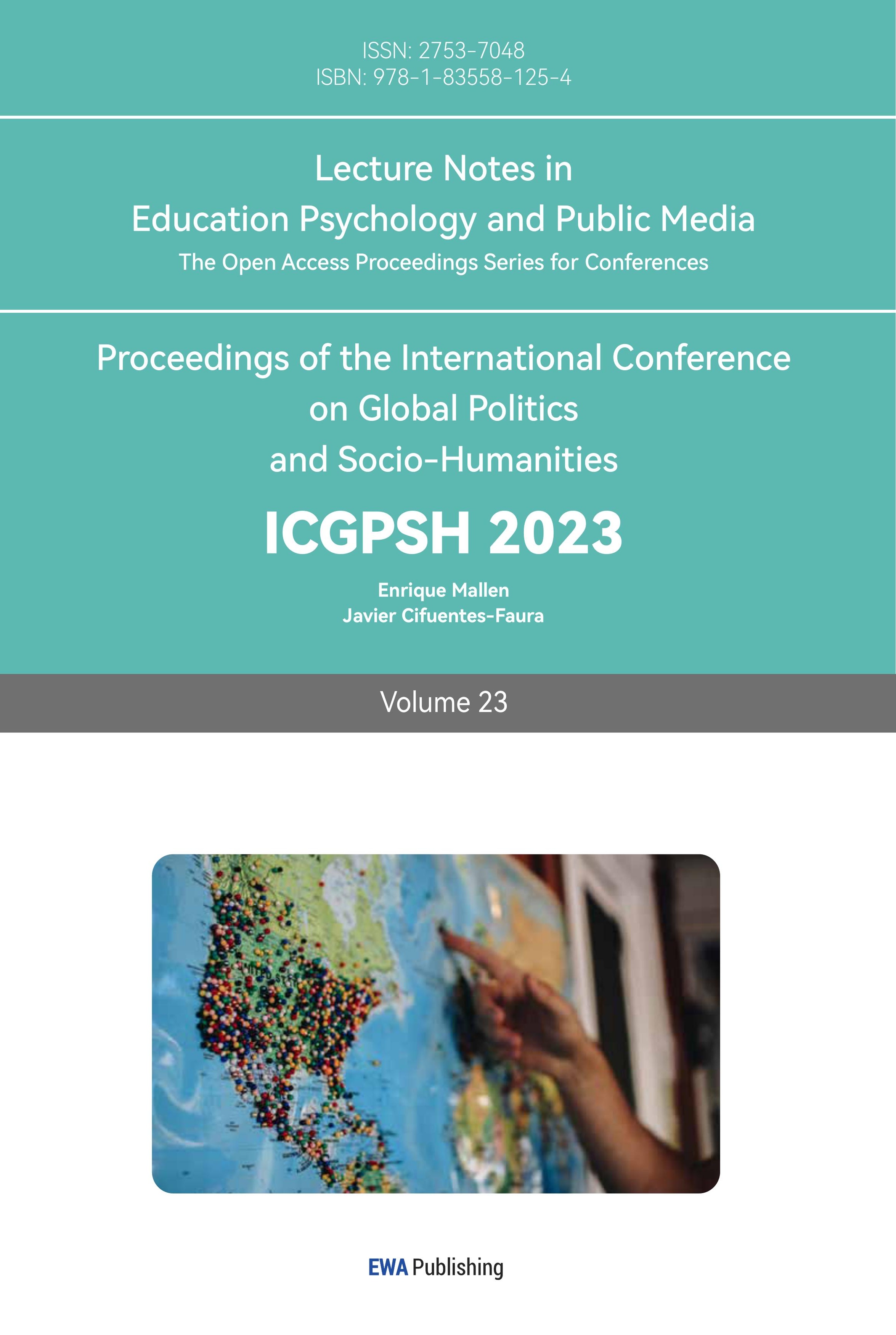References
[1]. Jenks, C., Lee, J. O., & Kanpol, B. (2001). Approaches to multicultural education in preservice teacher education: Philosophical frameworks and models for teaching. The urban review, 33, 87-105. https://doi.org/10.1023/A:1010389023211
[2]. Miled, N. (2019). Educational leaders’ perceptions of multicultural education in teachers’ professional development: A case study from a Canadian school district. Multicultural education review, 11(2), 79-95. https://doi.org/10.1080/2005615X.2019.1615249
[3]. Yoon, B., Simpson, A., & Haag, C. (2010). Assimilation ideology: Critically examining underlying messages in multicultural literature. Journal of Adolescent & Adult Literacy, 54(2), 109-118. https://doi.org/10.1598/JAAL.54.2.3
[4]. Gonzalez-Mena, J. (2008). Perceiving and responding to differences. In Diversity in early care and education: Honoring differences (pp. 9–24). essay, McGraw-Hill.
[5]. Alismail, H. A. (2016). Multicultural Education: Teachers’ Perceptions and Preparation. Journal of Education and Practice, 7(11), 139–146.
[6]. Fowler, D. J., & Brown, K. (2018). Data-driven decisions: Using equity theory to highlight implications for underserved students. AASA Journal of Scholarship & Practice, 14(4), 18-29. https://link.gale.com/apps/doc/A531709915/AONE?u=anon~be7296fc&sid=googleScholar&xid=20c07e5c
[7]. Merolla, D. M., & Jackson, O. (2019). Structural racism as the fundamental cause of the academic achievement gap. Sociology Compass, 13(6), e12696. https://doi.org/10.1111/soc4.12696
[8]. Sensoy, O., & DiAngelo, R. (2017). Is everyone really equal?: An introduction to key concepts in social justice education. Teachers College Press.
[9]. Bettez, S. (2017). Flipping the script from talking to teens about “celebrating diversity” to promoting equity through embracing vulnerability and enacting courage. Multicultural Perspectives, 19(2), 90–97. https://doi.org/10.1080/15210960.2017.1301091
[10]. Au, W. (2017). When multicultural education is not enough. Multicultural Perspectives, 19(3), 147–150. https://doi.org/10.1080/15210960.2017.1331741
[11]. Pollock, M. (2001). How the question we ask most about race in education is the very question we most suppress. Educational Researcher, 30(9), 2-11. https://doi.org/10.3102/0013189X030009002
[12]. Amadeo, K. (2022, January 29). How the Achievement Gap Affects Students (And the Rest of Us). The Balance. https://www.thebalancemoney.com/how-the-achievement-gap-affects-students-4690462#:~:text=The%20achievement%20gap%20negatively%20affects,there%20had%20been%20no%20gap.
[13]. Daniel, C. L. (2008). From liberal pluralism to critical multiculturalism: The need for a paradigm shift in multicultural education for social work practice in the United States. Journal of Progressive Human Services, 19(1), 19-38.
Cite this article
Chang,J. (2023). Anti-Oppressive Classrooms – Critical Framework of Multicultural Education. Lecture Notes in Education Psychology and Public Media,23,266-272.
Data availability
The datasets used and/or analyzed during the current study will be available from the authors upon reasonable request.
Disclaimer/Publisher's Note
The statements, opinions and data contained in all publications are solely those of the individual author(s) and contributor(s) and not of EWA Publishing and/or the editor(s). EWA Publishing and/or the editor(s) disclaim responsibility for any injury to people or property resulting from any ideas, methods, instructions or products referred to in the content.
About volume
Volume title: Proceedings of the International Conference on Global Politics and Socio-Humanities
© 2024 by the author(s). Licensee EWA Publishing, Oxford, UK. This article is an open access article distributed under the terms and
conditions of the Creative Commons Attribution (CC BY) license. Authors who
publish this series agree to the following terms:
1. Authors retain copyright and grant the series right of first publication with the work simultaneously licensed under a Creative Commons
Attribution License that allows others to share the work with an acknowledgment of the work's authorship and initial publication in this
series.
2. Authors are able to enter into separate, additional contractual arrangements for the non-exclusive distribution of the series's published
version of the work (e.g., post it to an institutional repository or publish it in a book), with an acknowledgment of its initial
publication in this series.
3. Authors are permitted and encouraged to post their work online (e.g., in institutional repositories or on their website) prior to and
during the submission process, as it can lead to productive exchanges, as well as earlier and greater citation of published work (See
Open access policy for details).
References
[1]. Jenks, C., Lee, J. O., & Kanpol, B. (2001). Approaches to multicultural education in preservice teacher education: Philosophical frameworks and models for teaching. The urban review, 33, 87-105. https://doi.org/10.1023/A:1010389023211
[2]. Miled, N. (2019). Educational leaders’ perceptions of multicultural education in teachers’ professional development: A case study from a Canadian school district. Multicultural education review, 11(2), 79-95. https://doi.org/10.1080/2005615X.2019.1615249
[3]. Yoon, B., Simpson, A., & Haag, C. (2010). Assimilation ideology: Critically examining underlying messages in multicultural literature. Journal of Adolescent & Adult Literacy, 54(2), 109-118. https://doi.org/10.1598/JAAL.54.2.3
[4]. Gonzalez-Mena, J. (2008). Perceiving and responding to differences. In Diversity in early care and education: Honoring differences (pp. 9–24). essay, McGraw-Hill.
[5]. Alismail, H. A. (2016). Multicultural Education: Teachers’ Perceptions and Preparation. Journal of Education and Practice, 7(11), 139–146.
[6]. Fowler, D. J., & Brown, K. (2018). Data-driven decisions: Using equity theory to highlight implications for underserved students. AASA Journal of Scholarship & Practice, 14(4), 18-29. https://link.gale.com/apps/doc/A531709915/AONE?u=anon~be7296fc&sid=googleScholar&xid=20c07e5c
[7]. Merolla, D. M., & Jackson, O. (2019). Structural racism as the fundamental cause of the academic achievement gap. Sociology Compass, 13(6), e12696. https://doi.org/10.1111/soc4.12696
[8]. Sensoy, O., & DiAngelo, R. (2017). Is everyone really equal?: An introduction to key concepts in social justice education. Teachers College Press.
[9]. Bettez, S. (2017). Flipping the script from talking to teens about “celebrating diversity” to promoting equity through embracing vulnerability and enacting courage. Multicultural Perspectives, 19(2), 90–97. https://doi.org/10.1080/15210960.2017.1301091
[10]. Au, W. (2017). When multicultural education is not enough. Multicultural Perspectives, 19(3), 147–150. https://doi.org/10.1080/15210960.2017.1331741
[11]. Pollock, M. (2001). How the question we ask most about race in education is the very question we most suppress. Educational Researcher, 30(9), 2-11. https://doi.org/10.3102/0013189X030009002
[12]. Amadeo, K. (2022, January 29). How the Achievement Gap Affects Students (And the Rest of Us). The Balance. https://www.thebalancemoney.com/how-the-achievement-gap-affects-students-4690462#:~:text=The%20achievement%20gap%20negatively%20affects,there%20had%20been%20no%20gap.
[13]. Daniel, C. L. (2008). From liberal pluralism to critical multiculturalism: The need for a paradigm shift in multicultural education for social work practice in the United States. Journal of Progressive Human Services, 19(1), 19-38.









